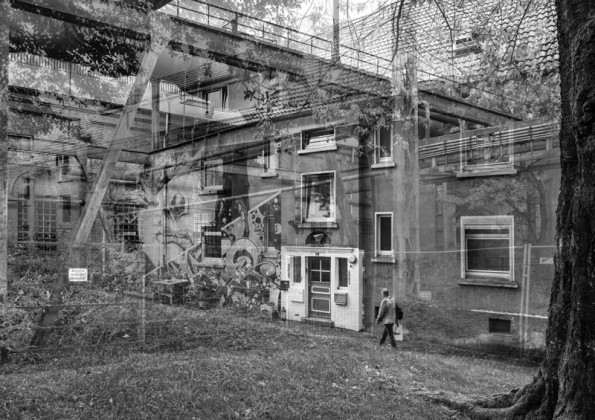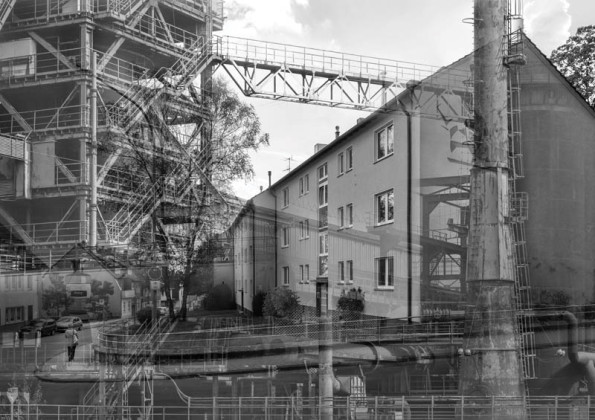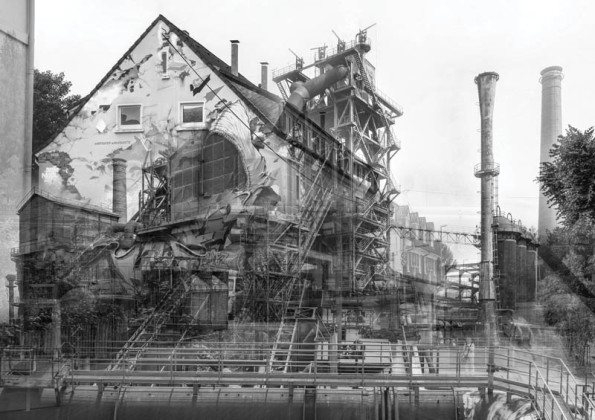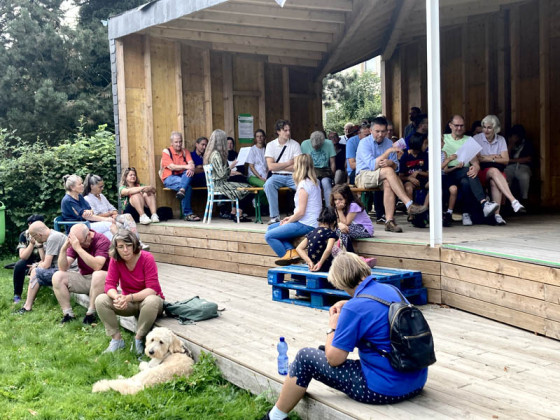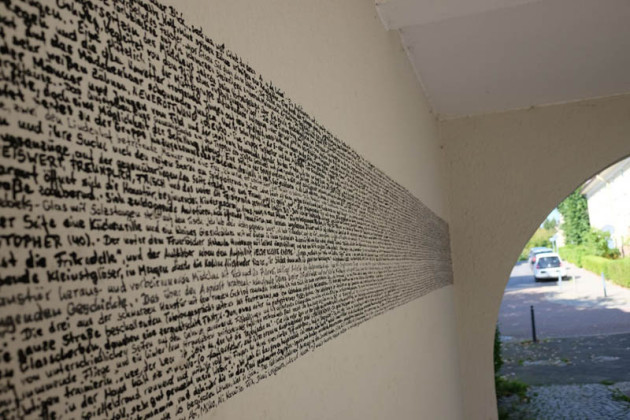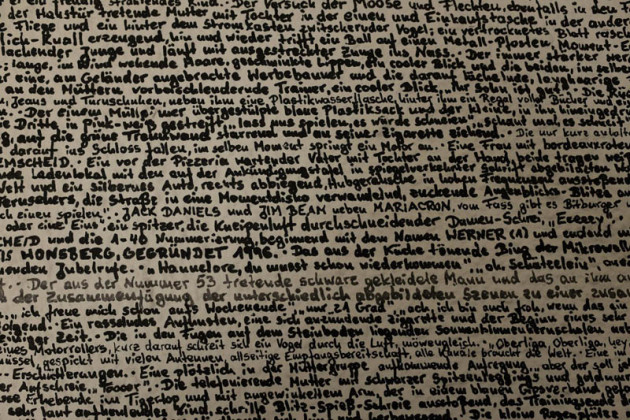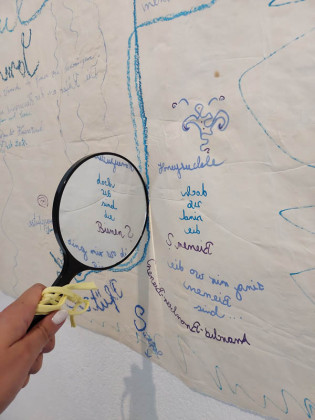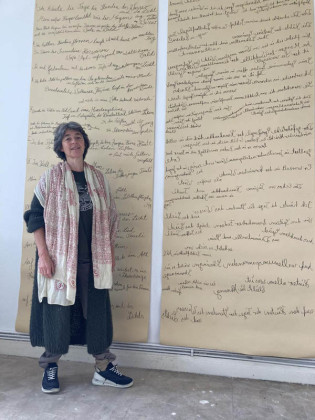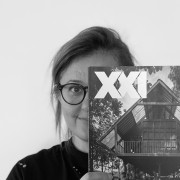Expanding Space: Transforming Honsberg through Art
In Germany Honsberg, a district of Remscheid with a rich history, the "Ins Blaue" project has been redefining urban spaces through art. Brought to life by a group of dedicated artists, this initiative has turned abandoned houses into vibrant studios, galleries, and event spaces. We have interviewed Katja Wickert, one of the curators of the organization and the artists involve - Vera Vorneweg, Adrienne Brehmer, Eva Wal and Hacer Bozkurt - exploring the inception of "Ins Blaue", this year's theme of "Expanding Space" and the impact of their creative endeavors on both the neighborhood and its residents.
Ferhan Yalçın: Can you tell us the story of "Ins Blaue"? What kind of organization is it, how was it founded, what is the background?
Katja Wickert: Honsberg, a district of Remscheid, is a former steel industry workers housing estate with characteristic apartment blocks from the 1920s. Here they had a place to live together, grow their vegetables in the gardens and use the recreational areas. After the big steel industries closed down, the character of the area changed and it became a place with a lot of social unrest. The once well socialised area became a place where people didn't want to live. More and more people moved away, leaving a lot of empty houses. Some of them were planed to be torn down in 2013. A Honsberger citizen had the idea to organise an art festival in the houses before they were demolished. It was an event with about 70 artists in ten houses - the initial spark of the Ins Blaue project. After this festival the housing association gave the chance for some artists to use the houses as studios on a temporary basis. In 2015 the artists founded the non-profit organisation Kulturwerktstatt Ins Blaue e.V., which finally managed in cooperation with the housing- association to rent eight houses with a total of 2000 squaremeters. Since five years the Kulturwerkstatt runs the houses self-administrated. The project, or “Ins Blaue” for short, now runs the non-profit Ins Blaue art gallery and an event location, rents out studios and some apartments, offers workshops, and organises festivals, concerts, theatre performances and various cultural events. The “Nachbarschaftswohnzimmer” is the latest project, which is planed to be a meeting point like a non profit café. Besides, as an result of the festival STREETS 2016, Honsberg also has kind of a Open-Air-Gallery for Streetart.
Meanwhile the image of the quartier changed and people realize that Honsberg turns to be a good place to live.
Ferhan Yalçın: How about this year’s theme, “Expanding Space”? How did it develop, and what is the inspiration behind it?
Katja Wickert: Due to the special situation in the neighbourhood and the vacancies on site, it was obvious to deal with the topic of space in the broadest sense. We wanted to give artists and residents the opportunity to rediscover the neighbourhood and create a certain added value for everyone. It was also about sharing ideas with residents about the future issues of our coexistence in general and exploring our own environment and reality of life through art.
Since 2020, we have therefore been exploring the topic of space and inviting artists from various disciplines to address changing issues. This year, for example, we were able to hold our second Artist in Residence programme under the title „expanding space“. The artists are invited to live and work on site, familiarising themselves with the surroundings and transforming what they see in there own artistic way. This results in very special works in connection with the neighbourhood and its residents. The repertoire is a colourful mix of readings, performances, video works, photographs, collages ans so on. The works are not only shown in the gallery, but are often created outside. This means that everyone can participate without the inhibition of having to enter a gallery.
Ferhan Yalçın: How does the selection process work? Are there any criteria for inviting the artists?
Katja Wickert: Every year, we set a new focus on the topic of space and incorporate findings from previous projects. We try to be as open as possible with the specifications for our Artist in Residence programm in order to give the artists enough freedom for their own ideas. We accompany the process on site, mediate and exchange ideas. But before we invite the artists to join our projects, we often hold discussions in which we consider whether and how the individual artists might fit together in a group. We make sure that the artists complement each other well and that exciting new collaborations can arise. It is also important for us to involve the local residents and for the artists to be able to get involved in working on site and dealing with the circumstances in their art.
Ferhan Yalçın: Can we get to know Vera, Adrienne, Eva, and Hacer, who have been selected for this year's Artist in Residence program? In which field do you mainly work?
Vera Vorneweg: I work in between literature and visual arts. I am writing on the one hand books (like a classical writer), but on the other hand I am also writing massive amounts of text in public space.
Adrienne Brehmer: I live and work as a freelance writer and book creator in Cologne. I specialise in writing prose and poetry. Numerous stories, short stories, miniatures and poems have appeared in anthologies, literary magazines and on the radio. My art books contain lyrical texts that are written on a specific theme. The texts are usually closely related to observations of nature or urban space.
Eva Wal: I am a visual artist as well as a poet connecting different media to what I want to say: word, sound, film, images, drawings, paintings.
As a special issue I weave my handwriting forward and backwards. In this manner I create graphic images trough handwriting.
Hacer Bozkurt: I am an architect and architectural photographer working locally and internationally. With my master education I have focused architectural photography studies. I work on commercial architectural photography and at the same time continue to think and produce some photo projects. Architecture is key element for perceiving the world around me and represent the relations around on my photos. I have joined many competitions and international exhibitions about relations between architecture and photography. My first solo photography exhibition Layers of Time was exhibited in Utopia Stadt in Wuppertal, and second one “Expanding Space“ exhibited in İnsblau in Remscheid. My photos were shown at various biennales and design weeks such as the International Rotterdam Architecture Biennale and Caldas Design Week.
Ferhan Yalçın: How you approach the theme? Maybe we can also talk about “urban space“. Is urban space your inspiration, or will your work lead to new inspiration for urban spaces?
Vera Vorneweg: Urban Space is my inspiration. I am sitting for a long time on the streets and in coffee shops, writing about the people passing by, but also writing about small things, like rubbish, little pieces of dialogues from people, advertisement passing by on cars etc. As I am writing these texts in German, there are not many texts translated. But last year I did a work in Yama Street Gallery in Nahariya (Israel) and for this project the first page of my text was translated. I put it in the appendix, so that you can have a look what literature I am writing on the streets...
And concerning the second part of your question: Yes, I think that my works are also leading to new inspiration for urban spaces as visual poetry is not a classical "art at building work". To confront people with text in literature on buildings is a chance for the design of creative urban spaces.
Adrienne Brehmer: I approach the topic of "Expanding space" through hikes and walks in my immediate surroundings and when travelling. For me, there is hardly anything more essential than sensing, experiencing and smelling space through walks. For me, urban space, exploring a neighbourhood, a row of houses, walking along paths and streets means expanding the inner and outer space. I absorb the scenery and begin to write about it. Sometimes this happens on the spot. Most of the time, however, I need some distance in order to talk about it. At some point, the urban space and I form a symbiosis. I enter the space and the space fulfils me. The exterior facades, for example, always have a certain odour. The running televisions in the windows become thunderstorms of colour at night. A single graffito can keep me in one place for hours. The voices of children, of young and old people are different in every city. They have colours and sounds. The strangeness of a city inspires me, motivates me and inevitably leads me to write new texts.
Eva Wal: My approach was an open mind, when I explored Honsberg at different times of the day, from the early morning into the evening: “Honsberg 6 to 6”. Sensual awareness for the environment, the setting of people of different cultures living together in a neighbourhood. Traces and imprints of life. Voices, sounds, smell, atmosphere. Houses and streets, marks, leftovers. Encounters.
I assembled my walking experiences in a brainstorm text, like a stream of conscience. This was my material to create a mind map in drawing and writing, forward as well as in mirror writing, that eventually filled the gallery space. This definitely was an intense experience, expanding space in the sense that inner and outer space fuse and the mind explores and grows as far as it is inspired.
Hacer Bozkurt: Maybe because of my main discipline I always interested in with buildings and relations around them. I think buildings are living mechanisms with their residents, natural and built surroundings. Built environment includes many stories and relations in different scales. For me to discover all these stories and movements between them is a joy. At the same time this is the way of perceiving life for me. On my works I focuses on making visible the invisible or hidden layers of the daily life of this environment. For making all this layers visible movement is the most important thing for me.
Ferhan Yalçın: What are your thoughts and observations about the process and the outcomes? Maybe we can talk about the exhibition and the audience’s reactions…
Vera Vorneweg: I started to write on a huge white wall. On this wall I put text that I wrote in the streets. As soon as I started writing on the wall, a lot of people stopped, asked questions and confronted themselves (without having planned this) with the text. Especially children were interested in my writings and usually I had a bunch of kids next to me talking and asking questions. There were also people that wished to see their names in the works. So we tried to formulate a sentence together so that they felt represented. I like it a lot to let people become part of the art works. And I also like that I am sharing the process of the creation with them. Anyway: All art and inspiration comes from the people and sometimes I just feel like a seismograph of the street, feeling all eruptions and movements.
Adrienne Brehmer: My thoughts or observations on the process are a deep urge to feel my way into other worlds and environments. Living in the flat of a worker's house and creating there for a certain period of time leads to a consistent process of writing and rethinking what has been written. All the artists had an intense time, which is common to the results. Whether photography, writing in public space or telling a story in the form of a performance about the Honsberg neighbourhood: the results are a very personal processing of each artist, which the audience received with great openness and interest. Many people asked us about our work and also about our respective careers. A relaxed atmosphere developed among the numerous visitors.
Eva Wal: My body and my mind worked as vehicles creating a visual image of this expansion. The process was first personal, private, but the aim was to share the outcome to communicate with people. It is an invitation.
In addition to the in situ work I presented work on the upper floor: video, paintings, mirror written poems. At the presentation I involved the visitors in a performance, grasping their spontaneous spoken words to produce a live written mind map of all. The reactions were surprise, interest, curiosity and joy.
Hacer Bozkurt: In my work, which I produced by spending my days in the industrial zones and my nights in Honsberg, like the workers of the region, I began to think about the differences or the similarities of the layers in all these regions. These industrial areas began to appear fragmentarily as new layers in the images of the region, which still represent the past, present, and perhaps the future of workers' housing. The invisible connections between these different environments began to become visible through the combination of layers from the industrial areas and within the region itself. In this series of photographs, where industrial elements and houses are seen as a single piece, natural elements are used as a unifying element.
In the opening day of the exhibition, we all artists found a change to meet the audiences in the site and represent our works them. Their interests and effort to understand the works is remarkable.
Related Content:
-

Big Top: The Circus Canteen
-

Tarq Gallery
-

Sister Sylvester and Deniz Tortum's "Shadowtime" Poses a Virtual Reality Check at SXSW
-

The Paint Store
-

"Into The Space" By Nakamura Kazunobu Design-Works
-
Sign Towards the Void
Suggesting that the presence of an object can make a space emptier than mere emptiness could ever dream of might be one of the most valuable insights into Anish Kapoor's work. This quality of extreme, generative emptiness can be seen throughout his work.
-

LaCalor Serigraphy Studio
-

Renzo Piano's Istanbul Modern is Open to Visitors
 05.01.2024
05.01.2024



